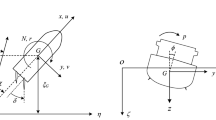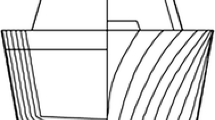Abstract
This paper demonstrates the effectiveness of using global optimal rudder control with the covariance matrix adaptation evolution strategy, applied to a surge-sway-yaw-roll coupled numerical model, in preventing broaching-to, occurring under conventional PD rudder controls in stern quartering waves. In particular, the PD control with optimized PD parameters is more efficient than the time history-optimized approach. With the help of stability analysis of surf-riding equilibria, two different mechanisms to successfully prevent broaching-to were identified: one is to tend to a periodic orbit with additional slight rudder actions and the other is to stay in surf-riding on a position of unstable equilibrium in regular waves for a longer duration with a larger differential gain. These outcomes could facilitate real-time prevention of broaching-to in actual seas.














Similar content being viewed by others
Abbreviations
- \(c\) :
-
Wave celerity
- F n :
-
Nominal Froude number
- \(g\) :
-
Acceleration due to gravity
- \(\text{GZ}\) :
-
Righting arm
- H :
-
Wave height
- \({I}_{xx}\) :
-
Moment of inertia in roll
- \({I}_{zz}\) :
-
Yaw moment of inertia
- \(J\) :
-
Objective function
- \({J}_{xx}\) :
-
Added roll moment of inertia
- \({J}_{zz}\) :
-
Added yaw moment of inertia
- \(K\) :
-
Penalty value for capsizing
- \({K}_{\rm{D}}\) :
-
Rudder differential gain
- \({K}_{p}\) :
-
Derivative of roll moment with respect to roll rate
- \({K}_{P}\) :
-
Rudder proportional gain
- \({K}_{r}\) :
-
Derivative of roll moment with respect to yaw rate
- \({K}_{v}\) :
-
Derivative of roll moment with respect to sway velocity
- \({K}_{w}\) :
-
Wave induced roll moment
- \({K}_{\delta }\) :
-
Derivative of roll moment with respect to rudder angle
- \({K}_{\phi }\) :
-
Derivative of roll moment with respect to roll angle
- \(m\) :
-
Ship mass
- \({m}_{x}\) :
-
Added mass in surge
- \({m}_{y}\) :
-
Added mass in sway
- \(n\) :
-
Propeller revolution number
- \({N}_{r}\) :
-
Derivative of yaw moment with respect to yaw rate
- \({N}_{v}\) :
-
Derivative of yaw moment with respect to sway velocity
- \({N}_{w}\) :
-
Wave induced yaw moment
- \({N}_{\delta }\) :
-
Derivative of yaw moment with respect to rudder angle
- \({N}_{\phi }\) :
-
Derivative of yaw moment with respect to roll angle.
- \(p\) :
-
Roll rate
- \(\mathbf{p}\) :
-
Control vector
- \(R\) :
-
Ship resistance
- \(r\) :
-
Yaw rate
- \({t}_{f}\) :
-
Final time
- \(t\) :
-
Time
- \(T\) :
-
Propeller thrust
- \({T}_{E}\) :
-
Time constant of steering gear
- \(u\) :
-
Surge velocity
- \(\mathbf{u}\) :
-
Control vector
- \(v\) :
-
Sway velocity
- \({\mathrm{v}_i}\) :
-
Eigenvector
- \(\mathbf{x}\) :
-
State vector
- \({X}_{w}\) :
-
Wave-induced surge force
- \({Y}_{r}\) :
-
Derivative of sway force with respect to yaw rate
- \({Y}_{v}\) :
-
Derivative of sway force with respect to sway velocity
- \({Y}_{W}\) :
-
Wave-induced sway force
- \({Y}_{\delta }\) :
-
Derivative of sway force with respect to rudder angle
- \({Y}_{\phi }\) :
-
Derivative of sway force with respect to roll angle
- \({Z}_{H}\) :
-
Height of center of sway force due to lateral motions
- \(\delta\) :
-
Rudder angle
- \(\upepsilon\) :
-
Small perturbation
- \(\lambda\) :
-
Wave length
- \(\phi\) :
-
Roll Angle
- \({\phi }_{v}\) :
-
Angle of vanishing stability
- \(\upchi\) :
-
Heading angle
- \({\chi }_{c}\) :
-
Desired heading angle for autopilot
- \({\upxi }_{\mathrm{G}}\) :
-
Longitudinal position of center of gravity from wave trough
References
IMO (2020) International code on intact stability 2008–2020 edition. IMO, London, p 19
Nicholson K (1974) Some parametric model experiments to investigate broaching-to. In: Bishop RED, Price WG (eds) The dynamics of marine vehicles and structure in waves. Mechanical Engineering, London, pp 160–166
Motora S, Fujino M, Fuwa T (1982) On the mechanism of broaching-to phenomena. In: Proceedings of the 2nd international conference on stability and ocean vehicles, The Society of Naval Architects of Japan, Tokyo, pp 535–550.
Renilson MR (1986) The seabrake—a device of assessing in the prevention of broaching-to. In: Proceeding of the Third international conference on stability of ships and ocean vehicles, Gdansk, vol 2, pp 75–80
Umeda N, Hamamoto M, Takagi M (1999) Model experiment on anti-broaching steering system. J Soc Naval Archit Jpn 185:41–48
Maki A, Umeda N, Ueno S (2008) Application of optimal control theory to course keeping problem in following seas. J Jpn Soc Naval Archit Ocean Eng 7:207–212 (In Japanese)
Wu AK, Miel A (1980) Sequential conjugate gradient−restoration algorithm for optimal control problems with nondifferential constraints and boundary conditions Part l. Optim Control Appl Methods 1:69–88
Maki A, Umeda N, Ueno S (2008) Investigation on broaching-to using optimal control theory. J Jpn Soc Naval Archit Ocean Eng 8:115–122 (In Japanese)
Maki A, Banno Y, Umeda N, Sakamoto N, Akimoto Y (2018) On broaching-to phenomenon using optimal control theory with evolutional strategy. Jpn Soc Naval Archit Ocean Eng 26:501–506
Maki A, Sakamoto N, Akimoto Y, Banno Y, Maniyappan S, Umeda N (2020) On broaching-to prevention using optimal control theory with evolutional strategy (CMA-ES). J Mar Sci Technol. https://doi.org/10.1007/s00773-020-00722-9
Auger A, Hansen N (2005) A restart CMA evolution strategy with increasing population size. In: Proceedings of the IEEE congress on evolutionary computation, pp 1769–1776.
Hansen N (2016) The CMA evolution strategy: a tutorial ArXiv e-prints. arXiv:1604.00772v1.
Umeda N (2000) Application of nonlinear dynamical system approach to ship capsize due to broaching in following and quartering seas, contemporary ideas on ship stability. Elsevier, Hoboken, pp 57–68
Umeda N (1999) Nonlinear dynamics on ship capsizing due to broaching in following and quartering seas. J Mar Sci Technol 4:16–26
ITTC: The specialist committee on the prediction of extreme ship motions and capsizing. In: Proceedings of the 23rd ITTC, vol 2.
Umeda N, Hamamoto M (2000) Capsize of ship models in following/ quartering waves—physical experiments and nonlinear dynamics. Philos Trans R Soc Lond Ser A 358:1883–1904
Umeda N, Vassalos D (1996) Non-linear periodic motions of a ship running in following and quartering seas. J Soc Naval Archit Jpn 179:89–101
Umeda N, Hashimoto M (2002) Qualitative aspects of nonlinear ship motions in following and quartering seas with high forward velocity. J Mar Sci Technol 6:111–121
Ohtsu K, Hasegawa K (1981) Evaluation and perspectives of autopilot. In: Proceedings of the 3rd symposium on ship maneuverability, The Society of Naval Architects of Japan (Tokyo), pp 243–279 (in Japanese).
Maki A, Umeda N (2009) Numerical prediction of the surf-riding threshold of a ship in stern quartering waves in the light of bifurcation theory. J Mar Sci Technol 14:80–88
Ott E, Grebogi C, Yorke JA (1990) Controlling chaos. Phys Rev Lett 64(11):1196–1199
Acknowledgements
This work was supported by a Grant-in-Aid for Scientific Research from the Japan Society for Promotion of Science (JSPS KAKENHI Grant Number 19H02360).
Author information
Authors and Affiliations
Corresponding author
Additional information
Publisher's Note
Springer Nature remains neutral with regard to jurisdictional claims in published maps and institutional affiliations.
About this article
Cite this article
Maniyappan, S., Umeda, N., Maki, A. et al. Effectiveness and mechanism of broaching-to prevention using global optimal control with evolution strategy (CMA-ES). J Mar Sci Technol 26, 382–394 (2021). https://doi.org/10.1007/s00773-020-00743-4
Received:
Accepted:
Published:
Issue Date:
DOI: https://doi.org/10.1007/s00773-020-00743-4




